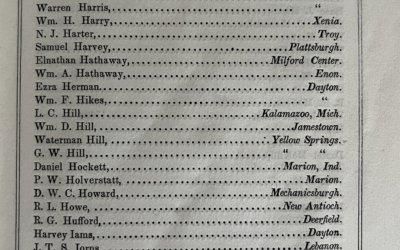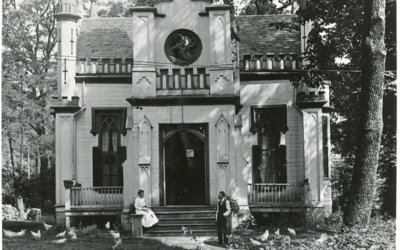 Hugh Taylor Birch, class of 1869, enjoyed many big moments in his long, eventful life. October 16th, 1936 was one such moment: when he dedicated a statue of Horace Mann in the Glen he named for his deceased daughter Helen and gave to Antioch College. That day kicked off a year-long observance of the centennial of public education in America, marked by Mann’s entry into the field when he accepted the appointment of first ever Secretary to the first ever State Board of Education in US history. The one hundred year celebration originated with Birch in the first place, and he donated funds and gave both inspiration and impetus to the National Education Association to make it a national event. Birch had Mann’s annual reports on education reprinted and a bust of Mann sculpted by William Rimmer mass produced, and hundreds of public schools were renamed for Mann across the country. At Antioch, where Birch first encountered the College’s first president, he installed a statue cast from the same mold that produced the original one by Emma Stebbins erected in Boston in 1865. Birch’s dedicatory remarks follow.
Hugh Taylor Birch, class of 1869, enjoyed many big moments in his long, eventful life. October 16th, 1936 was one such moment: when he dedicated a statue of Horace Mann in the Glen he named for his deceased daughter Helen and gave to Antioch College. That day kicked off a year-long observance of the centennial of public education in America, marked by Mann’s entry into the field when he accepted the appointment of first ever Secretary to the first ever State Board of Education in US history. The one hundred year celebration originated with Birch in the first place, and he donated funds and gave both inspiration and impetus to the National Education Association to make it a national event. Birch had Mann’s annual reports on education reprinted and a bust of Mann sculpted by William Rimmer mass produced, and hundreds of public schools were renamed for Mann across the country. At Antioch, where Birch first encountered the College’s first president, he installed a statue cast from the same mold that produced the original one by Emma Stebbins erected in Boston in 1865. Birch’s dedicatory remarks follow.
 The dedication was part of a symposium called “The Function of Education in a Democracy” featuring some of the most prominent educational minds of the time, including the president of MIT, Karl Compton, and famed professor and philosopher John Dewey of Columbia University. The weekend’s events also included the debut of a play about Mann and Antioch called Testament of Faith written by the College faculty and starring Arthur Lithgow (class of 1938). The symposium proceedings were published by the old Antioch Press in a volume entitled Educating For Democracy in 1937.
The dedication was part of a symposium called “The Function of Education in a Democracy” featuring some of the most prominent educational minds of the time, including the president of MIT, Karl Compton, and famed professor and philosopher John Dewey of Columbia University. The weekend’s events also included the debut of a play about Mann and Antioch called Testament of Faith written by the College faculty and starring Arthur Lithgow (class of 1938). The symposium proceedings were published by the old Antioch Press in a volume entitled Educating For Democracy in 1937.
Presentation of the Horace Mann Monument
HUGH TAYLOR BIRCH
My good friends: It is a delight to see you here today. This is one of my happy days. I have lived quite long and have had many of them, but today is a culmination of them all. I want to say to you, in a few words, what may surprise you. I knew Horace Mann. Eighty years ago this summer I was coming up one of the streets of Yellow Springs and met Horace Mann face to face. He held out his hand to me and I reached up and took it. And I want you to remember that in that handshake, that small boy of nine years received a thrill which in these eighty years since has not left me.
That is one reason I am here today. I had an inspiration from Horace Mann, and in all these eighty years that have passed, I have never forgotten that I owe to Horace Mann a deep debt of gratitude. I inquired, in every way that I knew how, to find out what was in that master spirit. He seemed to me to be above the rest. I as a boy fell in love with him, we might say, and in all the years and struggles that I passed through I have never forgotten him. Today we meet here face to face.
Horace Mann’s soul is in this statue, and I have brought it here for the benefit of the people of Ohio as well as the people connected with Antioch College. And I want it to inspire you, one and all, to some great deed in life, because Horace Mann believed in performance rather than in expression. He wanted everyone to be upright and honest and true, and to impress that upon his fellow men.
Eighty years have passed, and five or six years ago I came to Antioch a lone man. I had lost all my immediate family. The last one to go was my daughter, Helen; and when I saw Antioch and inquired about it, they said it was without ownership of the property in front of it. They had a few scattered acres, but had no place for the students to walk and play and be near to nature, so I conceived the idea of giving them a campus. That has been accomplished. They have a campus. Not only all of Antioch but all the people living in the vicinity have a great park that they are free to come and go in.
All institutions should have an inspiration from a great source; and I conceived the idea of giving such an inspiration to Antioch College after having been in Boston where I saw the original of Horace Mann’s statue brought from Munich in Germany. I conceived the idea of bringing to Antioch, where the spirit of Horace Mann was still lingering, a statue of Horace Mann; and with the help of my son-in-law, Frederick Clay Bartlett, we got in touch with the great foundry that made the first casting of Horace Mann’s statue, the one that is in Boston.
In the short correspondence, with the help of my son-in-law, we arranged to have the statue founded, and here it is today. I want you all to feel that humanity has been uplifted by the presence of this monument in this State. I want you all to reverence it, and I believe that Horace Mann will live again among you, and his great spirit will give you life to go on and do great things in the world.
Now, I am going to present to you this statue through my dear friend Mr. Corry. It belongs to Antioch College, the Village of Yellow Springs, and the State of Ohio. I believe that in Horace Mann, whose statue stands before you, the students of Antioch will have a patron saint to guide them along through life. I believe that his soul will rest here.
Mr. Corry, I have the greatest pleasure in the world, and the great honor, to give you the deed of this plot of ground and this beautiful statue for the benefit of Antioch College, its students, and its officers. I thank you.
“Songs From the Stacks” is a regular selection from Antiochiana: the Antioch College archives by College Archivist Scott Sanders.



